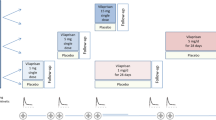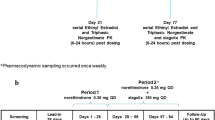Abstract
Objective
To study the impact of hormone-based contraceptives on the pharmacokinetics of oral trovafloxacin.
Methods
20 healthy premenopausal women, 10 taking hormonal contraception and 10 using non-hormonal methods, received a single 200mg oral dose of trovafloxacin. 16 plasma samples were collected prior to and for 24 hours after drug administration.
Results
Despite the high incidence of central nervous system- and gastrointestinal-related adverse events (≥80% in hormonal and non-hormonal groups), all participants completed the study. Results demonstrated that women using hormonal methods of contraception had significantly lower peak plasma concentrations (1.92 vs 2.27 mg/L, p = 0.03) than those using non-hormonal methods. They also demonstrated significantly higher clearance rates (9.96 vs 7.62 L/h, p < 0.004) and lower exposures (AUC) [20.8 vs 26.7 mg/L·h, p < 0.004] to the drug.
Conclusions
Based on previous studies, it is thought that the changes in trovafloxacin pharmacokinetics are secondary to induction or competition at cytochrome P-450 2C19 with the progestin components and/or an increase in phase II conjugation reactions by the estrogen components. However, a hormone-induced change in bioavailability cannot be ruled out as being responsible for the changes reported. The clinical significance of this interaction needs to be studied more fully. However, based on presently accepted pharmacodynamic drug administration parameters, the clinical effectiveness of trovafloxacin when used in premenopausal women receiving hormone-based contraceptives may be less than optimal, especially against pathogens with borderline sensitivities.


Similar content being viewed by others
References
Weisberg E. Interactions between oral contraceptives and anti-fungals/antibacterials. Is contraceptive failure the result? Clin Pharmacokinet 1999; 36: 309–13
Kashuba AD Jr, Bertino JS, Kearns GL, et al. Quantitation of three-month intraindividual variability of sex and menstrual cycle phase on CYP1A2, N-acetyltransferase-2, and xanthine oxidase activity determined with caffeine phenotyping. Clin Pharmacol Ther 1998; 63: 540–51
Kashuba AD, Bertino JS Jr, Rocci ML, et al. Quantification of 3-month intraindividual variability and the influence of sex and menstrual cycle phase on CYP3A activity as measured by phenotyping with intravenous midazolam. Clin Pharmacol Ther 1998; 64: 269–77
Kashuba AD, Nafziger AN, Kearns GL, et al. Quantification of intraindividual variability and the influence of menstrual cycle phase on CYP2D6 activity as measured by dextro-methorphan phenotyping. Pharmacogenetics 1998; 8: 403–10
Yamaoka K, Nakagawa T, Uno T. Application of Akaike’s Information Criterion (AIC) in the evaluation of linear pharmacokinetic equations. J Pharmacokinet Biopharm 1978; 6: 165–75
Teng R, Dogolo LC, Willavize SA, et al. Oral bioavailability of trovafloxacin with and without food in healthy volunteers. J Antimicrob Chemother 1997; 39 Suppl. B: 87–92
Vincent J, Venitz J, Teng R, et al. Pharmacokinetics and safety of trovafloxacin in healthy male volunteers following administration of single intravenous doses of the prodrug, alatrofloxacin. J Antimicrob Chemother 1997; 39Suppl B: 75–80
Trovan Product Information, Pfizer, Inc., December 1997
Teng R, Dogolo LC, Willavize SA, et al. Effect of Maalox and omeprazole on the bioavailability of trovafloxacin. J Antimicrob Chemother 1997; 39 Suppl. B: 93–7
Shenfield GM. Oral contraceptives. Are drug interactions of clinical significance? Drug Safety 1993; 9: 21–37
Forrest A, Nix DE, Ballow CH, et al. Pharmacodynamics of intravenous ciprofloxacin in seriously ill patients. Antimicrob Agents Chemother 1993; 37: 1073–81
Preston SL, Drusano GL, Berman AL, et al. Pharmacodynamics of levofloxacin: a new paradigm for early clinical trials. JAMA 1998; 279: 125–9
Amsden GW, Graci DM, Cabelus LJ, et al. Arandomized, crossover design study of the pharmacology of extended-spectrum fluoroquinolones for pneumococcal infections. Chest 1999; 116: 115–9
Acknowledgements
This study was supported by the E. Donnall Thomas Resident Research Program in Internal Medicine of Bassett Healthcare.
The authors would like to thank Dr Joseph S. Bertino, Jr for his assistance with this manuscript.
Author information
Authors and Affiliations
Corresponding author
Rights and permissions
About this article
Cite this article
Amsden, G.W., Mohamed, M.A. & Menhinick, A.M. Effect of Hormonal Contraceptives on the Pharmacokinetics of Trovafloxacin in Women. Clin. Drug Investig. 21, 281–286 (2001). https://doi.org/10.2165/00044011-200121040-00006
Published:
Issue Date:
DOI: https://doi.org/10.2165/00044011-200121040-00006




